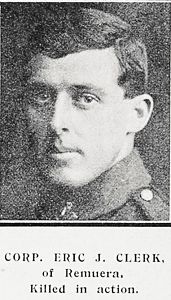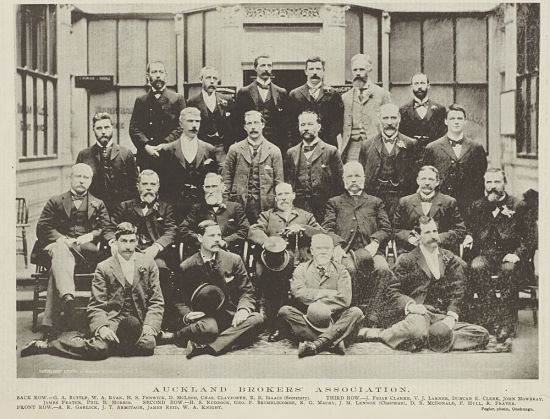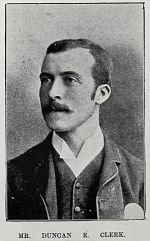WW1 Corporal Eric John Sinclair Clerk 12/2546
Eric John Sinclair Clerk (12/2546) was born in Sydney on 3 December 1891. He was the only son of Duncan Edward Clerk (Service number 18489) (1863 – 1941) and Madge Clerk (nee Bruce) (1866 – 1942) of Arney Road, and later 30 Bassett Road, Remuera, Auckland.
A daughter was born on 11 May 1896 in Auckland. [1] Eric’s father, Duncan Edward Clerk, described himself as a ‘settler’ coming from Warwickshire, England via Sydney, Australia, where he was married to Madge Bruce on 28 January 1891 in Sydney, by Reverend W. Bruce. Duncan was also a stock and share broker, and was part-owner, with H.T. Twiss, of the Elfindale Tea Company importing tea from the plantation in Ceylon (now Sri Lanka). He played bowls and was, for a time, president of the Remuera Bowling Club. [2, 3, 4] Duncan enlisted in the Army as a Driver in the Army Service Corps, joining in August 1916, at the age of 43, maybe as a result of his son’s death in July 1916. He was discharged in 1919, serving his time in the in England working at the Training Camp at Sling and in London.
From 1903 – 1908, Eric John Sinclair Clerk attended King’s College. At the time of his enlistment on 29 August 1914, he was working as a Station hand on G.J. Williams’ farm at Tuparoa on the remote East Coast of New Zealand. Eric served as a Private in the Auckland Infantry Battalion, with the Samoan Advanced Party from September 1914 to April 1915. At completion of Samoan duties, he sailed for Suez, Egypt on 13 June 1916 on HNZAT ‘Maunganui’ with the 5th Reinforcements arriving on 24 July 1915. He was sent to Gallipoli where he was wounded by a gunshot wound to his scalp, admitted to hospital at Mudros, Egypt to recuperate, re-joining his unit on 22 September 1915. He returned to Egypt and whilst there he was promoted to Corporal on 6 March 1916.
A month later, Eric was sent to the Western Front in France. In France, they attended courses on grenades, trench warfare, and machine-gunnery, amongst other things, so they could circulate new ideas to the ranks as soon as possible. The New Zealanders had to read and absorb far more official material than they had been required to in Gallipoli or Egypt. Censorship and rules were tightened around the use of personal cameras in the front line (private photos of the Western Front are very rare compared to those of Gallipoli). The new environment also meant new equipment. The New Zealanders received gas masks to wear for protection against chlorine and phosgene poison gases, and everyone had to practise new gas drills and attend live demonstrations at British gas warfare schools. New Zealand soldiers began wearing the new rounded steel helmet and, unlike at Gallipoli, were well supplied with grenades and the firepower of Lewis Guns. [4]
The Somme offensive began on 1 July 1916 and was to last five long months, with battles in bad weather, poor terrain, and gaining little ground at a huge cost of lives. On the 21 July 1916 Eric was killed in action in the battle of the Somme, Northern France. He is buried at Cite Bonjean Military Cemetery, Armentieres, France II. E. 42. He was awarded the 1914-1915 Star, British War Medal and the Victory Medal. He is remembered on the King’s College Roll of Honour WW1 and on the Auckland Council Orakei Local Board area World War 1 Roll of Honour [5]


